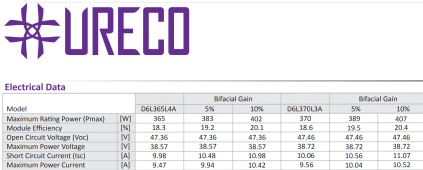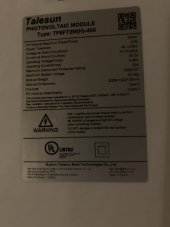Stormsoul
New Member
- Joined
- Jul 4, 2021
- Messages
- 43
I don't know where to start this, so I will just start with this. I have spent money and now need help installing/wiring/configuring. I got a few quotes for some parts of the heavy lifting and wire running and that's coming in at 12-14k depending on the quote. It is like I pulled the trigger, after watching videos and looking at my monthly usage and I think I am in the ballpark but installing it is overwhelming now. Below I will just list some generic info with side thought. I can provide specifics if needed.
Location-Tucson AZ
large back patio rolled shingle (new) mounting location for 24 400w panels. These are Talesuns 9.89 amp and 49.1 voc.
Inverters-LVX 6048 (yellow) inverters x2. We use a lot of power for family of 4 (19 and 21 yo use a lot).
Mounting hardware was ordered to match the panels from Santan and is K2/Everest racking. Planning surface mount on patio w/ no elevation. I will wash more often.
Batteries- 32 280ah cells from Amy. I actually received those a tad early from China so that was good. These came well packaged and have hardware. (depending on how I build these I will probably need additional l longer bus bar hardware. I don't know what my wiring diagram will be but I was thinking of 2x16 cell to bus bar managed by BMS from Overkill solar.
Installer will provide combiner boxes, disconnects, wire runs from back to front for AC and DC, sub panel. I will program inverters and build battery and tie into inverter.
I have the rolls of wire for the panels. I know there are some various wires missing. I would have to attach pictures but the run from back patio to garage is probably 150 feet. That leads to the beginning of my questions. garage mount of inverters and battery setup either on a rack like Will did or a Craftsman tool box like solar engineer did.. but then wiring diagram and BMS choice I dont know, will be very very hot in the summer. So that plan with local installer was and I agree was under back patio on outside of back bedroom wall. Again, large covered patio, that is safe from rain or direct sun. In the garage everything will be nice and close together but will need to be nice and tight against the wall as I still park cars in it. It is just the heat I worry about. The inverters will probably overtemp, Batteries would be ok and they wont freeze in the winter. They wont freeze on the back patio as if it even gets that close (very rare) I can point a small space heater in the area and be fine for the one or two nights a year we may get that cold.
I know this is just rambling right now as I have spent a lot and now need to pay my way out of this project and will end up not saving much more than just paying someone to do it all from start to finish..well I do get to pick the panels I guess but I digress. The long run of DC and AC from back patio to main panel at the garage and then from there into a sub panel and back to inverters is where I think cost is adding up. The features being listed by installer will be that the grid can assist the inverters powering sub panel load if panels and battery get to low. I like the idea and everything but kitchen and laundry would be moved to sub..
Ok thats enough for now. Right now feel like I need a couple solar buddies to learn from and maybe help me install all of this. I have read a lot and want to use some of these tools I bought, I just need someone looking over my shoulder and stop me before I incorrectly do something. Thanks in advance for any help.
Location-Tucson AZ
large back patio rolled shingle (new) mounting location for 24 400w panels. These are Talesuns 9.89 amp and 49.1 voc.
Inverters-LVX 6048 (yellow) inverters x2. We use a lot of power for family of 4 (19 and 21 yo use a lot).
Mounting hardware was ordered to match the panels from Santan and is K2/Everest racking. Planning surface mount on patio w/ no elevation. I will wash more often.
Batteries- 32 280ah cells from Amy. I actually received those a tad early from China so that was good. These came well packaged and have hardware. (depending on how I build these I will probably need additional l longer bus bar hardware. I don't know what my wiring diagram will be but I was thinking of 2x16 cell to bus bar managed by BMS from Overkill solar.
Installer will provide combiner boxes, disconnects, wire runs from back to front for AC and DC, sub panel. I will program inverters and build battery and tie into inverter.
I have the rolls of wire for the panels. I know there are some various wires missing. I would have to attach pictures but the run from back patio to garage is probably 150 feet. That leads to the beginning of my questions. garage mount of inverters and battery setup either on a rack like Will did or a Craftsman tool box like solar engineer did.. but then wiring diagram and BMS choice I dont know, will be very very hot in the summer. So that plan with local installer was and I agree was under back patio on outside of back bedroom wall. Again, large covered patio, that is safe from rain or direct sun. In the garage everything will be nice and close together but will need to be nice and tight against the wall as I still park cars in it. It is just the heat I worry about. The inverters will probably overtemp, Batteries would be ok and they wont freeze in the winter. They wont freeze on the back patio as if it even gets that close (very rare) I can point a small space heater in the area and be fine for the one or two nights a year we may get that cold.
I know this is just rambling right now as I have spent a lot and now need to pay my way out of this project and will end up not saving much more than just paying someone to do it all from start to finish..well I do get to pick the panels I guess but I digress. The long run of DC and AC from back patio to main panel at the garage and then from there into a sub panel and back to inverters is where I think cost is adding up. The features being listed by installer will be that the grid can assist the inverters powering sub panel load if panels and battery get to low. I like the idea and everything but kitchen and laundry would be moved to sub..
Ok thats enough for now. Right now feel like I need a couple solar buddies to learn from and maybe help me install all of this. I have read a lot and want to use some of these tools I bought, I just need someone looking over my shoulder and stop me before I incorrectly do something. Thanks in advance for any help.





